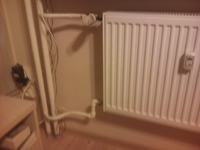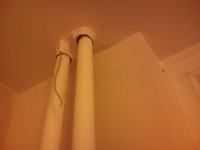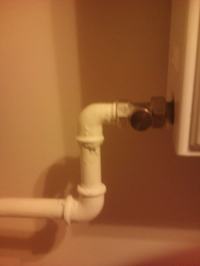Hello. Gentlemen, I have a big, bothersome problem with the CO pipe knocking. I will describe my situation as precisely as possible.
In one of the rooms I found that the return CO pipe was knocking. These knocks are sometimes absent for a few hours, but can be heard every day. The oscillation of knocking in the tube ranges from every 2-5 sec. To every 20 sec.
I live in a block of 13 floors, on the 7th floor. Only the return tube is knocking. It seems to me that the knocking occurs as the temperature of the water in the tube changes. Usually the tube is cool, but a slight warming / cooling down is enough for it to start making a tapping noise. For example, when a neighbor 2 floors above turns on the heater and the pipe starts to heat up, it knocks.
The tubes pass through the ceiling and floor, embedded in rolled sheet metal sleeves.
During this vacation, the team indicated by the cooperatives replaced all the radiators with steel panel Purmo. Unfortunately, it seems to me that during the exchange in one room, they made a mistake and cut the radiator tubes incorrectly. It seems to me that the return tube is about a centimeter too long in relation to the supply tube, as a result of which the vertical return tube has been pressed against one wall of the sleeve in the floor and cannot move freely in it, the same is the case with the warm supply tube water that has been pressed against the sleeve in the ceiling and it seems to me that it cannot move freely, but the feed tube does not knock - maybe because the temperature of the water in this tube does not fluctuate so much.
It seems to me that the knock is to blame for this return tube being too tight and pressed against the sleeve, which has made it unable to move freely.
I would like to ask you colleagues what do you think about this?
There is one more issue and I do not know if it can affect this knocking, so I painted both tubes with white metal paint already in the heating season as they were relatively warm. As the paint was white and the color of the tubes was silver, I had to cover them with quite a thick layer, additionally from the side of the wall, the brush did not come up anymore, so the tubes are not painted there. Could this painting have any impact?
I will add that:
The heater is vented.
The radiator is mounted on plastic washers.
Even when I turn off the radiator on the upper and lower valves, the knocking does not stop.
I go to sleep - knocks, I get up knocking. Sometimes harder, sometimes weaker, sometimes more often, sometimes less often. It's bad for my mental health :)
On Monday, the administration is to send someone to evaluate the situation - but so far I would like to eliminate all possible problems on my side.
I am asking for help and opinions.
In one of the rooms I found that the return CO pipe was knocking. These knocks are sometimes absent for a few hours, but can be heard every day. The oscillation of knocking in the tube ranges from every 2-5 sec. To every 20 sec.
I live in a block of 13 floors, on the 7th floor. Only the return tube is knocking. It seems to me that the knocking occurs as the temperature of the water in the tube changes. Usually the tube is cool, but a slight warming / cooling down is enough for it to start making a tapping noise. For example, when a neighbor 2 floors above turns on the heater and the pipe starts to heat up, it knocks.
The tubes pass through the ceiling and floor, embedded in rolled sheet metal sleeves.
During this vacation, the team indicated by the cooperatives replaced all the radiators with steel panel Purmo. Unfortunately, it seems to me that during the exchange in one room, they made a mistake and cut the radiator tubes incorrectly. It seems to me that the return tube is about a centimeter too long in relation to the supply tube, as a result of which the vertical return tube has been pressed against one wall of the sleeve in the floor and cannot move freely in it, the same is the case with the warm supply tube water that has been pressed against the sleeve in the ceiling and it seems to me that it cannot move freely, but the feed tube does not knock - maybe because the temperature of the water in this tube does not fluctuate so much.
It seems to me that the knock is to blame for this return tube being too tight and pressed against the sleeve, which has made it unable to move freely.
I would like to ask you colleagues what do you think about this?
There is one more issue and I do not know if it can affect this knocking, so I painted both tubes with white metal paint already in the heating season as they were relatively warm. As the paint was white and the color of the tubes was silver, I had to cover them with quite a thick layer, additionally from the side of the wall, the brush did not come up anymore, so the tubes are not painted there. Could this painting have any impact?
I will add that:
The heater is vented.
The radiator is mounted on plastic washers.
Even when I turn off the radiator on the upper and lower valves, the knocking does not stop.
I go to sleep - knocks, I get up knocking. Sometimes harder, sometimes weaker, sometimes more often, sometimes less often. It's bad for my mental health :)
On Monday, the administration is to send someone to evaluate the situation - but so far I would like to eliminate all possible problems on my side.
I am asking for help and opinions.







